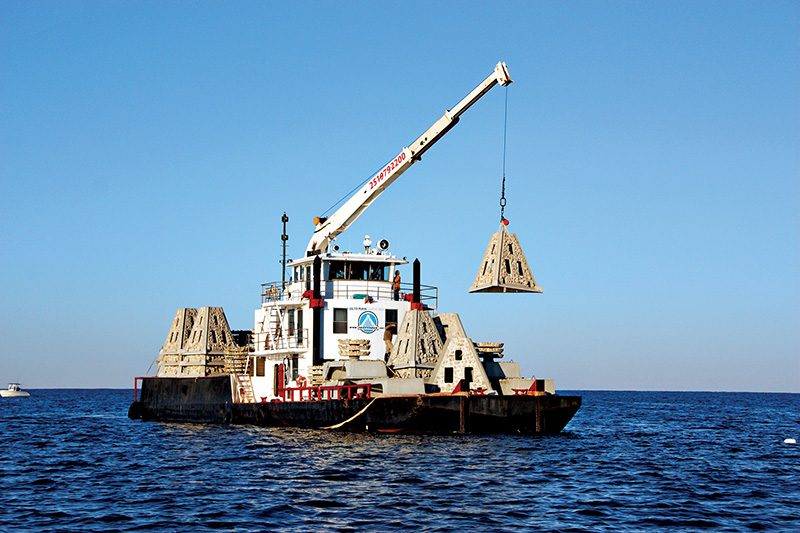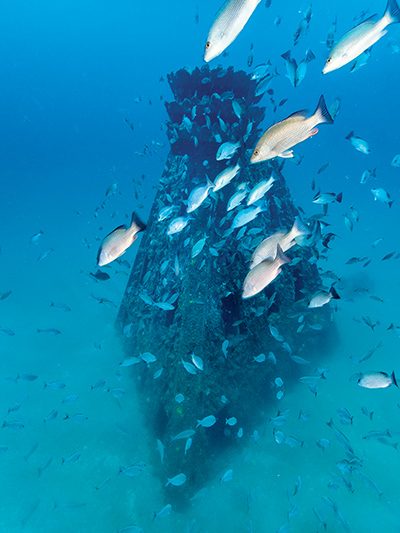
PADA BULAN JUNI 2019 SAYA MELAKUKAN PENYELAMAN PERTAMA SAYA setelah delapan bulan memperbaiki rumah kami di Mexico Beach, Florida, dari kerusakan akibat Badai Michael. Setelah akhirnya pulih dari badai, saya kembali melakukan survei bawah air sebagai penyelam sukarelawan untuk Asosiasi Terumbu Buatan Pantai Meksiko (MBARA).
Pada suatu hari di bulan Juni yang indah, saya dan teman saya menuju ke Teluk Meksiko untuk memeriksa kondisi terumbu buatan dan kehidupan yang tertarik padanya. Kami menurunkan tali jangkar di lokasi dengan tiga terumbu karang di kedalaman 95 kaki. Setiap struktur berbentuk piramida memiliki tinggi 16 kaki dan berat 18 ton.
As we neared the bottom, I’m sure my face mirrored the look of disbelief on my buddy’s. Two of the structures were tipped over. I couldn’t fathom the force needed to topple these massive reefs deep below the surface. It was important to capture this incident in photos and a survey because this information would impact artificial reef designs in the future.
Divers can assist with monitoring artificial reefs and gather information that helps improve the reefs’ durability and performance. For example, 8-foot-tall (2,4 meters) pyramid structures are popular because they are durable and stack easily on a deployment vessel, but divers observed low levels of marine diversity. By experimenting with different designs, we learned that a reef had more diversity when an artificial reef with many small layers, forming an ecosystem, was placed next to the pyramids. The ecosystem attracts smaller fish and provides foraging opportunities for the larger fish.
Kami mengamati bahwa ekosistem di atas struktur terumbu yang lebih besar rentan terhadap kerusakan akibat jangkar kapal ketika kami menemukan jangkar tersebut terlepas dari beberapa terumbu dan berada di dasar laut. Badai Michael menunjukkan bahwa terumbu karang dengan ekosistem yang utuh memiliki beban yang lebih berat dan lebih mungkin untuk tumbang. Sekarang kami sering menggunakan ekosistem yang bersarang di dalam, menggantung di dalam piramida besar dengan tali seperti genta lonceng.
Penyelam mengumpulkan sampel dari terumbu karang yang ditempatkan dan memberikan laporan kepada Komisi Konservasi Ikan dan Satwa Liar Florida (FWC). Informasi ini membantu memastikan terumbu karang ditempatkan sebagaimana mestinya dan dalam kondisi yang baik, tidak kusut di dasar laut.
Diver surveys of artificial reef marine life contribute to science — the FWC has adopted the Reef Environmental Education Foundation (REEF) citizen science program for doing fish surveys. REEF provides training on fish identification and how to conduct surveys, and in return divers contribute to their extensive marine fish database. The information is available to the public, and scientists often use it.
If you are a diver in a coastal area, consider reaching out to your local artificial reef association. It’s a great way to bring new purpose to your dives. You may even find an organization that will cover some of your dive expenses. In Florida, contact the FWC to ask about an active artificial reef organization near you. AD

© Alert Diver - Q2 2023